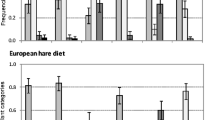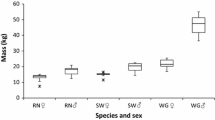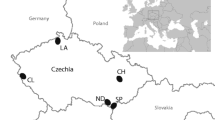Abstract
To assess the fitness consequences of foraging on patchy resources, consumption rates, growth rates and survivorship of Armadillidium vulgare were monitored while feeding in arenas in which the spatial distribution of patches of high quality food (powdered dicotyledonous leaf litter) was varied within a matrix of low quality food (powdered grass leaf litter). Predictions from behavioural experiments that these fitness correlates would be lower when high quality food is more heterogeneously distributed in space were tested but not supported either by laboratory or field experiments. To investigate whether A. vulgare can develop the ability to relocate high quality food patches, changes in foraging behaviour, over a comparable time period to that used in the fitness experiments, were monitored in arenas in which there was a high quality food patch in a low quality matrix. A. vulgare increased its ability to relocate the position of high quality food over time. It reduced time spent in low quality food matrices and increased time spent in high quality food patches with time after the start of the experiment. When the position of a high quality food patch was moved, the time spent in the low quality food matrix increased and less time was spent in high quality food patches, compared to arenas in which the food was not moved. The fitness benefits for saprophages of developing the ability to relocate high quality patches while foraging in spatially heterogeneous environments are discussed.



Similar content being viewed by others
References
Belovsky GE (1978) Diet optimization in a generalist herbivore: moose. Theor Popul Biol 14:105–134
Belovsky GE (1984) Herbivore optimal foraging: a comparative test of three models. Am Nat 124:97–115
Bernays EA, Chapman RF (1994) Host-plant selection by phytophagous insects. Chapman & Hall, New York, London
Bernays EA, Wrubel RP (1985) Learning by grasshoppers: association of colour/light intensity with food. Physiol Entomol 10:359–369
Cadish G, Giller KE (1997) Driven by nature: plant litter quality and decomposition. CAB International, Wallingford
Charnov EL (1976) Optimal foraging, the marginal value theorem. Theor Popul Biol 9:129–136
Crawley MJ (1983) Herbivory: the dynamics of animal–plant interactions. Blackwell Scientific Publications, Oxford
Cunningham JP, West SA, Wright DJ (1998) Learning in the nectar foraging behaviour of Helicoverpa armigera. Ecol Entomol 23:363–369
Cuthill IC, Kacelnik A, Krebs JR, Haccou P, Icurasa Y (1990) Patch use by starlings: the effect of recent experience on foraging decisions. Anim Behav 40:625–640
De Perera TB (2004) Spatial parameters encoded in the spatial map of the blind Mexican cave fish, Astyanax fasciatus. Anim Behav 68:291–295
Dukas R, Real LA (1991) Learning foraging tasks by bees: a comparison between social and solitary species. Anim Behav 42:269–276
Dyer FC (1996) Spatial memory and navigation by honeybees on the scale of the foraging range. J Exp Biol 199:147–154
Egas M, Norde DJ, Sabelis MW (2003) Adaptive learning in arthropods: spider mites learn to distinguish food quality. Exp Appl Acarol 30:233–247
Goldberg LA, Hart WE, Wilson DB (1999) Learning foraging thresholds for lizards: an analysis of a simple learning algorithm. J Theor Biol 197:361–369
Gunnarsson T (1987) Selective feeding on a maple leaf by Oniscus asellus (Isopoda). Pedobiology 30:161–165
Hammer M, Menzel R (1995) Learning and memory in the honeybee. J Neurosci 15:1617–1630
Hassall M (1996) Spatial variation in favourability of a grass heath as a habitat for woodlice (Isopoda: Oniscidea). Pedobiology 40:514–528
Hassall M, Riddington R, Helden A (2001) Foraging behaviour of brent geese, Branta b. bernicla, on grasslands: effects of sward length and nitrogen content. Oecologia 127:97–104
Hassall M, Rushton SP (1984) Feeding behaviour of terrestrial isopods in relation to plant defences and microbial decay. In: Sutton SL, Holdich D (eds) Proceedings of the Zoological Society of London, Symposium No. 53, pp 487–505
Hassall M, Tuck JM, Smith DW, Gilroy JJ, Addison RK (2002) Effects of spatial heterogeneity on feeding behaviour of Porcellio scaber (Isopoda: Oniscidea). Eur J Soil Biol 38:53–57
Hoffmann G (1985) The influence of landmarks on the systematic search behavior of the desert isopod Hemilepistus reaumuri. 1. Role of the landmark made by the animal. Behav Ecol Sociobiol 17:325–334
Howery LD, Bailey DW, Ruyle GB, Renken WJ (2000) Cattle use visual cues to track food locations. Appl Anim Behav Sci 67:1–14
Hughes RN, Blight CM (2000) Two intertidal fish species use visual association learning to track the status of food patches in a radial maze. Anim Behav 59:613–621
Hughes RN, Seed R (1995) Behavioural mechanisms of prey selection in crabs. J Exp Marine Biol Ecol 193:225–238
Krebs JR, Inman AJ (1992) Learning and foraging: individuals, groups and populations. Am Nat 140 Suppl 5:563–584
Krebs JR, Kacelnik A, Taylor P (1978) Test of optimal sampling by foraging great tits. Nature 275:27–31
Krebs JR, McCleery RH (1984) Optimization in behavioural ecology. In: Krebs JR, Davies NB (eds) Behavioural ecology: an evolutionary approach. Blackwell Scientific Publications, Oxford, pp 91–121
Lawlor LR (1976) Parent investment and offspring fitness in the terrestrial isopod Armadillidum vulgare (Latr.) (Crustacea: Oniscoidea). Evolution 31:775–785
McNaughton SJ (1988) Mineral nutrition and spatial concentrations of African ungulates. Nature 334:343–345
McNaughton SJ (1990) Mineral nutrition and seasonal movements of African migratory ungulates. Nature 345:613–615
Ney-Nifle M, Keasar T, Shmida A (2001) Location and colour learning in bumblebees in a two-phase conditioning experiment. J Insect Behav 14:697–711
Parsons AJ, Dumont B (2003) Spational heterogeneity and grazing processes. Anim Res 52:161–179
Rebar CE (1995) Ability of Dipodomys-merriami and Chaetodipus-intermedius to locate resource distributions. J Mammal 76:437–447
Rushton SP, Hassall M (1983) The effects of food quality on the life history parameters of the terrestrial isopod Armadillidium vulgare (Latreille). Oecologia 57:257–261
Rushton SP, Hassall M (1987) Effects of food quality on isopod population dynamics. Funct Ecol 1:359–367
Siemers BM (2001) Finding prey by associative learning in gleaning bats: experiments with a Natterer’s bat Myotis nattereri. Acta Chiropterol 3:211–215
Shettleworth SJ, Krebs JR, Stephens DW, Gibbon J (1988) Tracking a fluctuating environment: a study of sampling. Anim Behav 36:87–105
Stephens DW, Krebs JR (1986) Foraging theory. In: Krebs JR, Clutton-Brock T (eds) Monographs in behavior and ecology. Princeton University Press, Princeton, New Jersey
Sumpter DJT, Beekman M (2003) From nonlinearity to optimality: pheromone trail foraging by ants. Anim Behav 66:273–280
Takeda N (1984) The aggregation phenomenon in terrestrial isopods. In: Sutton SL, Holdich DM (eds) The biology of terrestrial isopods. Proceedings of a symposium held at the Zoological Society of London on 7th and 8th of July 1983, vol 53, pp 381–404, Clarendon, Oxford
Tamm S (1987) Tracking varying environments:sampling by hummingbirds. Anim Behav 35:1725–1734
Tinbergen N, van Kruyt W (1938) Über die Orientierung des Bienenwolfes (Philanthus triangulum Fabr.). III. Die Bevorzugung bestimmter Wegmarken. Z Vergl Physiol 25:292–334
Tuck JM (2001) Effects of spatial heterogeneity on the ecology of terrestrial isopods. PhD Thesis, University of East Anglia, Norwich
Tuck JM, Hassall M (2004) Foraging behaviour of Armadillidium vulgare (Isopoda: Oniscidea) in heterogeneous environments. Behaviour 141:233–244
Tumlinson JH, Turlings TCJ, Lewis WJ (1993) Semiochemically mediated foraging behavior in beneficial parasitic insects. Arch Insect Biochem Physiol 22:385–391
Vet LEM, De Jong AG, Franchi E, Papaj DR (1998) The effect of complete versus incomplete information on odour discrimination in a parasitic wasp. Anim Behav 55:1271–1279
Warburton K (2003) Learning of foraging skills by fish. Fish Fisheries 4:203–215
White TCR (1993) The inadequate environment: nitrogen and the abundance of animals. Springer-Verlag, Berlin
Wilmshurst JF, Fryxell JM, Hudson RJ (1995) Forage quality and patch choice by wapiti (Cervus elaphus). Behav Ecol 6:209–217
Zimmer M, Kautz G, Topp W (1996) Olfaction in terrestrial isopods (Isopoda: Oniscidea): the responses of Porcellio scaber to the odour of litter. Eur J Soil Biol 32:141–147
Acknowledgements
We are very grateful to Jenny Stevenson for help with the fieldwork. This work was funded by a studentship from the Natural Environment Research Council. We thank two anonymous referees for helpful comments on an earlier version of this paper
Author information
Authors and Affiliations
Corresponding author
Additional information
Communicated by D. Gwynne
Rights and permissions
About this article
Cite this article
Tuck, J.M., Hassall, M. Locating food in a spatially heterogeneous environment: Implications for fitness of the macrodecomposer Armadillidium vulgare (Isopoda: Oniscidea). Behav Ecol Sociobiol 58, 545–551 (2005). https://doi.org/10.1007/s00265-005-0959-x
Received:
Revised:
Accepted:
Published:
Issue Date:
DOI: https://doi.org/10.1007/s00265-005-0959-x




